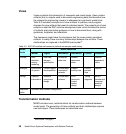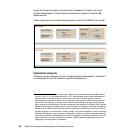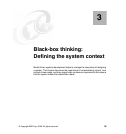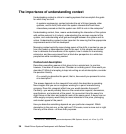
36 Model Driven Systems Development with Rational Products
The importance of understanding context
Understanding context is critical in creating systems that accomplish the goals
for which they are built.
In systems engineering, context includes the set of things (people, other
systems, and so forth) with which the system interacts and how those
interactions proceed so that the system can fulfill its role in the enterprise.
1
Understanding context, then, means understanding the interaction of the system
with entities external to it (actors), understanding the services required of the
system, and understanding what gets exchanged between the system and its
actors. Understanding context is also important for ensuring that the appropriate
requirements exist or will be developed.
Managing context explicitly means being aware of the shifts in context as you go
from one model or decomposition level to the next. In this chapter we discuss
how to delineate the boundaries of the system, how it relates to its enclosing
enterprise, and how we proceed from a black-box perspective to a white-box
perspective while maintaining context.
Context and description
Describing something seems at first glace to be a simple task. In practice,
however, a number of issues arise. Consider an ordinary pencil. How would you
describe it? While it is tempting to leap into writing an actual description, consider
the question literally.
How would you describe the pencil, that is, how would you proceed to arrive
at a description?
The answer depends on the viewpoint from which the describer is operating.
Now imagine that you are an engineer working for a pencil manufacturing
company. Does this viewpoint affect how you would describe the pencil?
Certainly—you would probably focus on the construction aspects, dimensions,
specifications, and materials of the pencil. An accountant from the same firm
might focus on the labor and material costs of the same pencil. A buyer from an
office supply company would likely be more interested in the price, packaging,
and market appeal of the pencil.
How you describe something depends on your particular viewpoint. Which
description is the real one, or the right one? Of course, none is more real or right
than any of the others—all have their purposes.
1
Balmelli et al., Model-driven systems development, IBM Systems Journal, vol. 45 no. 3, p. 576


















